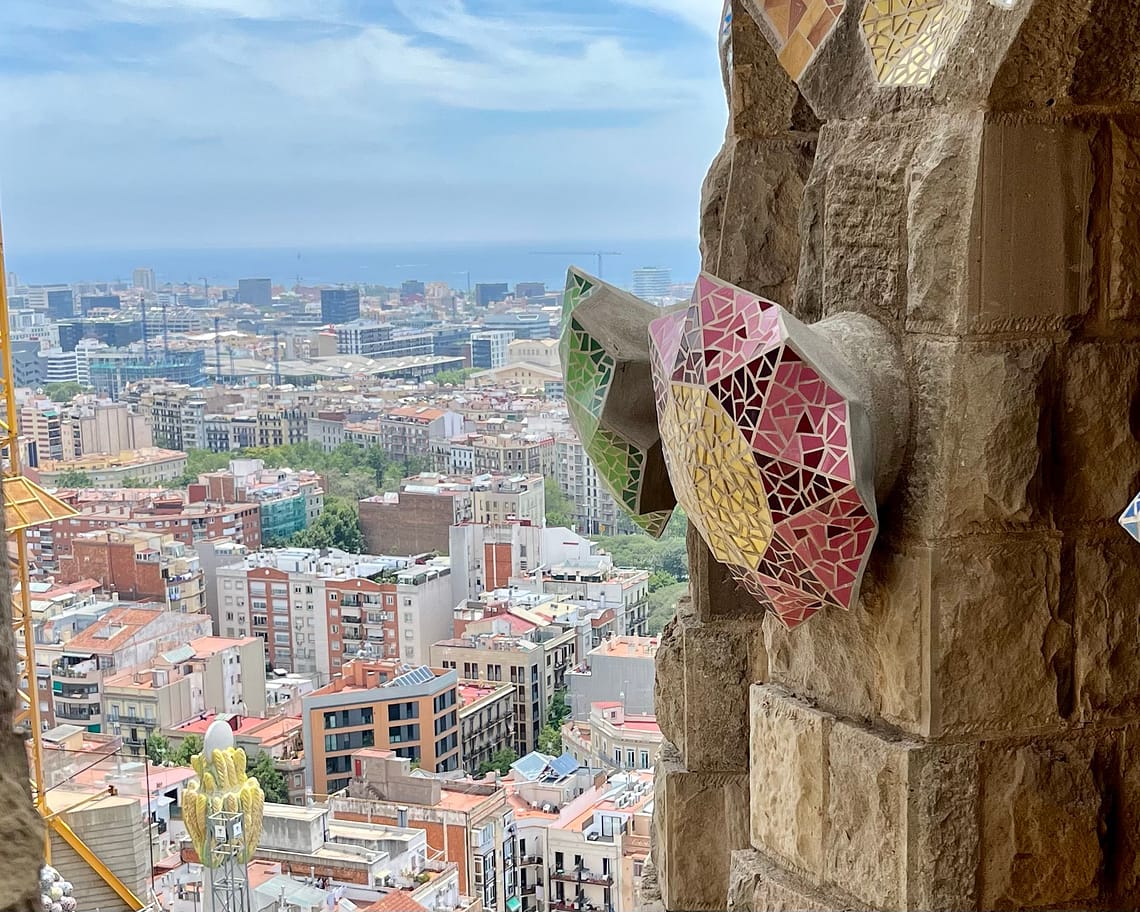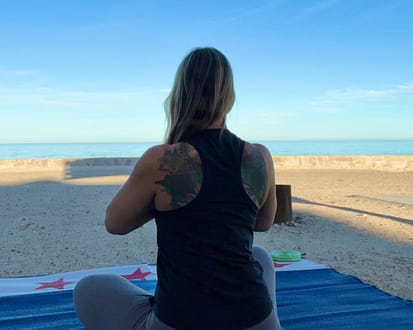Do you want to see all the top sights in Barcelona, but only have three days? Follow my weekend-long itinerary to help make planning your visit easy! I travelled here with my Mom three days before taking a Mediterranean cruise for my 40th birthday, and I have to say, it’s one of my favourite cities I’ve ever visited.
Three Days in Barcelona: Day One
Best way to fly to Europe: overnight baby! We checked into Toronto Pearson, had some dinner and wine and departed at 10:30 pm. It will never not be weird waking up in what you think is the morning, and it’s actually the the afternoon, but such is the way with a six hour time change. We took a taxi to our hotel, El Avenida Palace, an older, but beautifully restored hotel with a luxurious old-world lobby, a grand spiral staircase, simple, comfortable rooms, and a good-sized breakfast spread in the mornings. It also had a rooftop bar and pool for panoramic city views! Fun facts: it’s owned by the former Vice President of the FC Barcelona football team, and The Beatles stayed here in 1965! It’s in the heart of the city center, and when you only have three days to see Barcelona, that’s where you want to be! It’s at the intersection where the shopping district on Passeig de Gràcia starts. We were walking distance to restaurants and shops, close to the famous “La Rambla” and Plaza Catalunya.
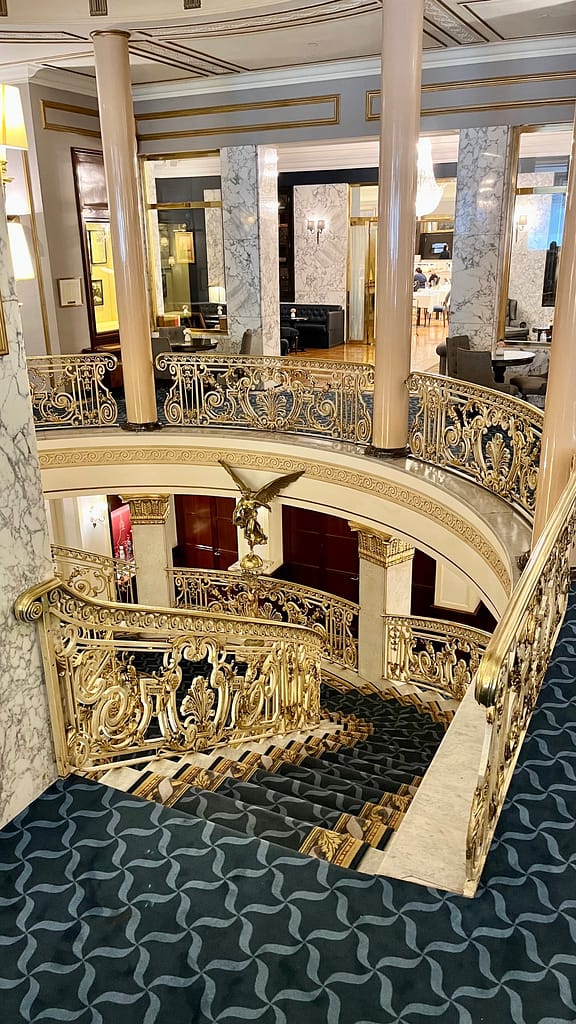
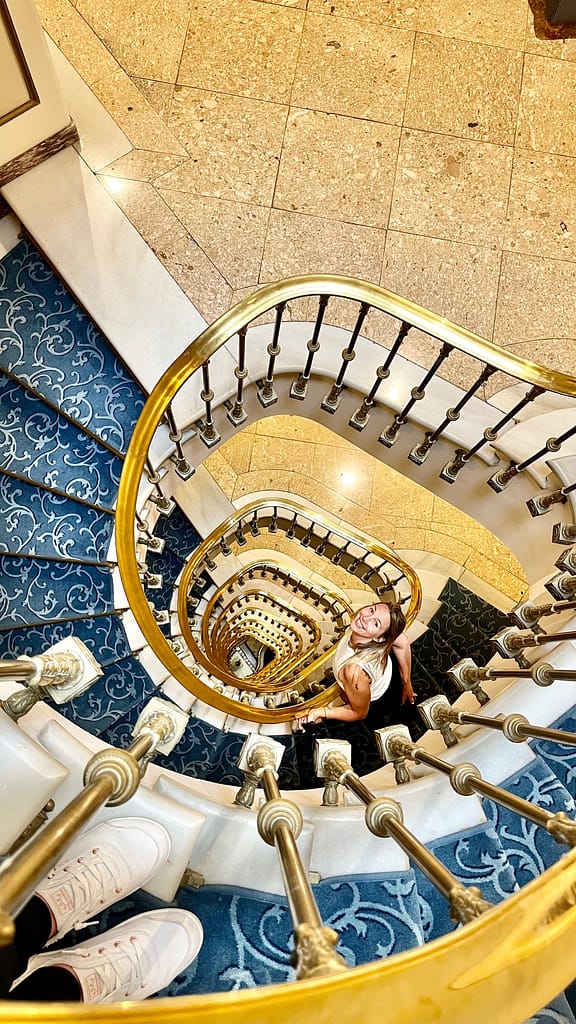
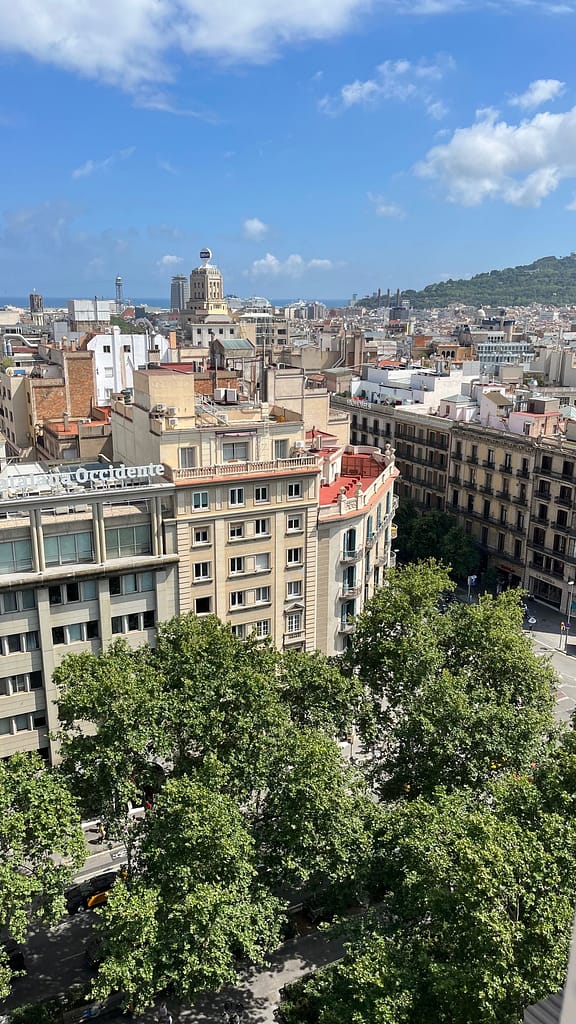
Wine & Tapas for lunch in the street
What do you do for your first afternoon in Barcelona? Sit down at a streetside restaurant for wine and tapas and to people watch, of course! We did this on the next street over from our hotel as soon as we dropped our luggage off and freshened up. The first thing that stood out to me: the fashion! Everyone here was so well-dressed… for a coffee or drink in the street with a friend, for walking their dogs, for running to the corner store, I couldn’t stop looking! I couldn’t believe how effortlessly glamourous and put-together everyone looked.
La Rambla
After a little rest, we decided to wander down to La Rambla for dinner and sight-seeing. If you don’t know what La Rambla is, it’s the most popular street for tourists in Barcelona. It’s pedestrian-only, about 1.2 km, and really pretty with its lush lines of trees, growing right alongside the old towering city buildings on either side. It starts up in Plaza Catalunya and goes down to Port Vell, where you can see a statue of Christopher Columbus. The promenade itself has kiosks selling souvenirs and art, outdoor restaurants, cafes, and bars, shopping and street performers. There are several historical buildings, the popular La Bouqueria Market, and a mosaic by Joan Miró.


Montjuïc & a Sunset Cable Car Ride
After dinner we hopped in a taxi and made our way up to wander the grounds of Castell Montjuïc, the old military fortress circa the 1700’s, the property itself having history much older than that. This site, with it’s 360 degree views of the city and sea, saw battle in the Reaper’s War in 1640, and the War of the Spanish Succession in the early 1700’s, and the execution of the president of the Catalan Government in 1940. Since then the castle has been a prison, a weapons museum, and is now owned by the city council of Barcelona.
From here, we hopped on the Funicular just in time to watch the sunset over the mountains across the city. There’s a few different options for cable car rides around the city, one is down closer to the beach and looked super cool as well!

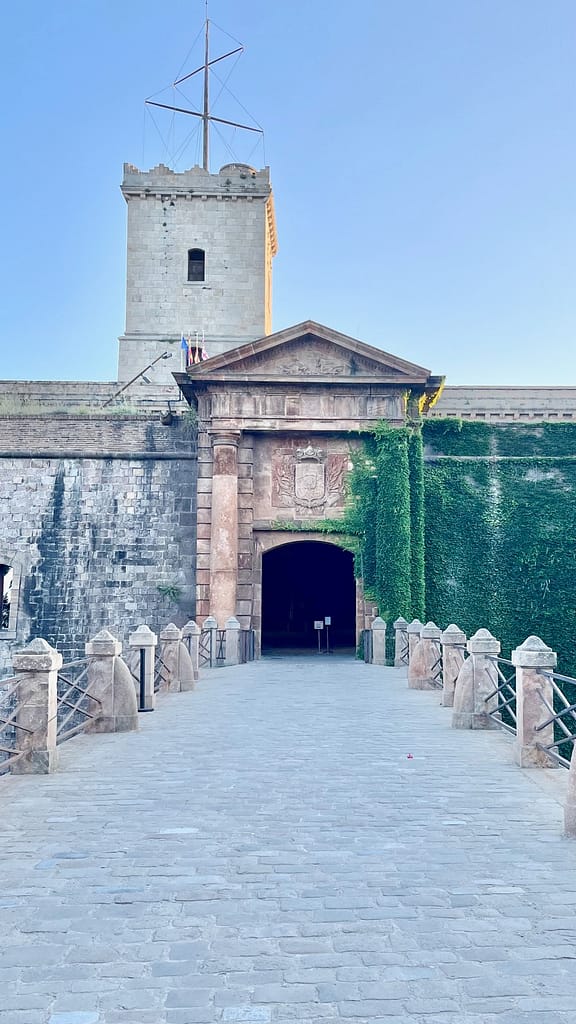

Three Days in Barcelona: Day Two
Hop-on Hop-off bus and touring the city sites
One of my favourite ways to see a big city in a limited amount of time is to do the hop-on hop-off bus tour. For three reasons (other than the fact that you only have three days to see the top sights in Barcelona):
- They’re informative: you get to learn a lot about so many different parts of the city, things you wouldn’t learn just wandering around and exploring sites on your own
- It can save you time: you get to see a lot more, and without and without the hassle of trying to navigate unfamiliar traffic/routes on your own, find parking which can take up extra time.
- It can save you money: you can use them as a taxi to get you from place to place, for the whole day, or the whole weekend, depending on the ticket you get. If you take a lot of taxis to all these places, it adds up. If you rent a car, it’s likely more than the ticket, plus you’re paying for parking a lot of the time.

So this is what we did for Saturday. Luckily, the pickup was right near our hotel in Plaza Catalunya. Of the two routes, we did one early in the morning, and one later on in the afternoon. We saw multiple sites designed by architect Antoni Gaudí like Casa Batlló – a famous dragon-inspired house, his other building, La Pedrera, La Sagrada Familia, Barcelona’s most famous church, and his magical Park Güell. We saw FC Barcelona’s home stadium: Camp Nou, Barrio Gótico, Ports Olimpíc and Vell, with stunning sea views, Montjuïc Castle, and so much more!
Touring La Sagrada Familia Basilica
I’d highly recommend a guided tour (usually not my thing) to understand the hidden intricacies, the architecture and design, and Gaudí’s passion for the project and his faith. You can visit on your own, but there’s so much you would miss if you went this route. We did ours in the late morning after our bus tour…
La Sagrada Familia is Barcelona’s most famous church. It has been under construction for 140 years! Construction started in 1882, and is hoped to be finished sometime around 2030. It is architect Antoni Gaudí’s most famous project. He worked on it for the last 43 years of his life until he was killed by a tram crossing the street on his way to daily confession. It’s been said that he knew he would never see it to completion and that it would take several generations to complete. He famously stated “my client is not in a hurry”. Construction is funded solely by anonymous donations to finish Gaudí’s plans that were left behind.
Words cannot describe the vastness of this structure… from the first moments standing outside the Basilica and seeing the 18 towers and countless stone figures high above, to your first steps inside to see the curved, tree-like columns and plethora of multi-coloured stained glass windows, your head is forever on a swivel and your mouth agape.
The Basilica has three facades on the exterior:
- the Navity – the oldest, depicting the birth of Christ, almost fairytale-like with endless human and animal figures
- the Passion – the crucifixion of Christ, more dramatic with long leaning pillars and the human figures having a more skeletal-like look
- the Glory facade – the tallest, still uncomplete, depicts Christ is Heaven the glory of Jesus after death
Without having a guide to explain this and point out all the intricate details, I would never have known or understood the design and details. Gaudí had a reason for every detail of his design: of the 18 towers, 12 represent the apostles, four for the evangelists, one for Mary and one for Jesus. Each of the 36 columns inside represent something or someone different, and is made from a different material. Gaudí’s “Magic Square” can be spotted, which is a quadrant of numbers, four rows by four columns, and each way you add up a row or column, they equal 33, the age of Christ at his death. The thought in the details is endless…



Park Güell
Park Güell, another Gaudí masterpiece, of a totally different medium. In the early 1900’s when Barcelona starting booming, the wealthy inhabitants desired housing outside of the city center to escape overpopulation and the the polluted air from their money-generating factories. In comes Antoni Gaudí with his unlimited financial freedom and creativity to plan an extravagant housing community for these factory and business owners to flaunt and display their wealth. Wealthy entrepreneur, Eusebi Güell purchased a small mountain overlooking the city with just that intention, commissioning Gaudí to have free reign in the architectural design.
Unfortunately, lack of interest in buying these homes led to housing construction ending after two of the sixty proposed houses were completed. However, Gaudí had put in the infrastructure of the neighbourhood first. This included, raised roadways covering fairytale-like pedestrian paths, a large raised plaza over a marketplace with 86 massive stone columns. The park is adorned with stunning mosaic in multiple sculptures and a curved bench that snakes around the the plaza grounds with a view overlooking the city and sea. It has colourful flowers, an extravagant entranceway. You can tour the home that Gaudí lived in for twenty years there, until his death in 1926.



An evening in Barceloneta
After a much-needed siesta, we took a taxi down to the seaside neighbourhood of Barceloneta to meet some of Mum’s friends for dinner. Barceloneta was originally a fisherman’s village, and keeps a small village feel. The beach here is one of Barcelona’s oldest, and most popular, and people come here to sunbathe, surf, boat, dine and party. There were families finishing up their lazy beach day, people playing volleyball, taking a stroll on the palm tree lined boardwalk, and dining on seafood paella and tapas al fresco.
Our restaurant of choice: Carpe Diem! This unique restaurant serves middle-eastern and Asian fusion dishes, has open-air views to the beach and sea and turns into a nightclub in the evening. The super-cool setting includes moody lighting, Balinese-style booths with canopies, an ornate carved wood bar, large buddhas and great music. We shared delicious seafoods, sushi, curries and wines and sipped on martinis. After dessert, and watched the other guests get massages right at their tables!
We decided to get on our way, and walk off some of the food, and made an unexpected stop at the Ice Bar, a place where the room is -10 degrees Celsius and decorated with carved ice. Here we were given winter jackets before entering, and enjoyed a quick beverage, took our mandatory photos, and got the heck out of there! Brr!



From here, we walked our friends back to their hotel, the Hotel Arts Barcelona, which was a stunning spot, with excellent city and sea views, and just a short walk from the beach. We had one more quick night cap at the beautiful (and bustling) hotel bar, P41, before catching a taxi ride home.
Three Days in Barcelona: Day Three
For our last day, we walked up Passeig de Gràcia and we had a cappuccino and croissant in the street. We window-shopped the designer stores like Gucci, Prada and Jimmy Choo. We also got a more up-close look at a couple of Gaudí’s buildings…
Casa Battló
Casa Battló is a World UNESCO Heritage site, and another of Gaudí’s whimsical designs in the “Block of Discord”, an area famous for notable Modernista style buildings. It’s been said to have a marine-like design to it, with waving lines in the façade and masks for balconies. The roof has scales to look like an arched back of a dragon, with a four-point cross on it. You can tour it, for a fee.
Casa Milà (also called “La Pedrera”) was Gaudí’s last private residence he was commissioned to design, and it’s also deemed a World Heritage site. It doesn’t fit his usual fantasy-like style, and wasn’t always loved by the community like it is now. These days you can tour it, or just enjoy the beautiful, bistro-style restaurant in the main floor “El Cafè de La Pedrera”.

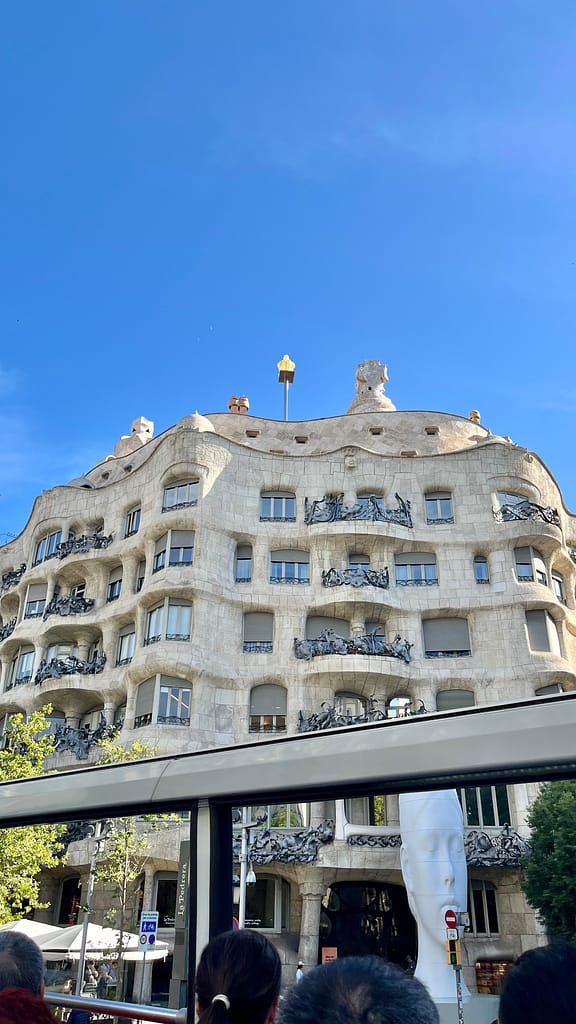
Before we left this part of town, we had to shop a little more. We were on a mission to buy a couple of dresses for our upcoming Virgin Voyages cruise that left from here that afternoon!
Thanks for reading “What to See in Barcelona in Three Days”. I hope it helped inspire you to explore in a new way, and you enjoy your visit to this beautiful city!
Stay itchy. -Ash
